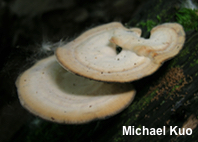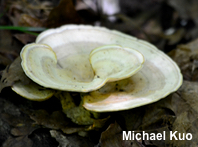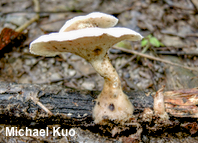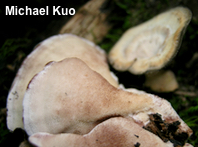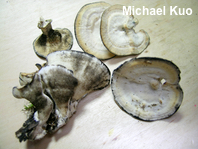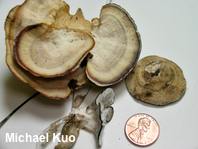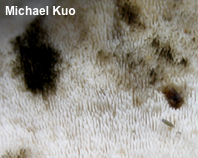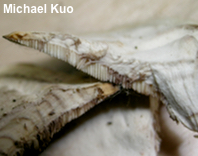| Major Groups > Toothed Mushrooms > Mycorrhaphium adustum |

|
[ Basidiomycota > Polyporales > Phanerochaetaceae > Mycorrhaphium . . . ] Mycorrhaphium adustum by Michael Kuo, 30 June 2024 This little toothed mushroom belongs to the Polyporales, but is usually treated in field guides as it is at this site, with other mushrooms that have teeth or spines. Mycorrhaphium adustum can be found in summer and fall on the sticks and small logs of hardwoods in eastern North America, and is easily recognized by the teeth on its underside, the pale cap with a blackening margin (the epithet adustum means "charred" or "burned"), and the gray to black bruising reactions of the cap and underside. The similar Mycorrhaphium adustulum is smaller (cap 1–2 cm across) and does not blacken; it is also prone to developing resupinate or effused-reflexed forms. Meripilus sumstinei has a blackening margin and other blackening surfaces, but is much larger at maturity and features pores rather than teeth. Steccherinum adustum is a synonym. Bjerkandera adusta is not a synonym, but a different mushroom with minute pores rather than teeth. Description: Ecology: Saprobic on the deadwood of hardwoods; growing alone or in clusters on sticks or small logs rather than larger logs or stumps; summer and fall; originally described from North Carolina (Schweinitz 1822); widely distributed in North America east of the Great Plains; reliably documented from the Caribbean, Central America, Brazil, and Russia (records from eastern Asia probably represent Mycorrhaphium subadustum). The illustrated and described collections are from Illinois. Cap: 4–8 cm across; sometimes circular in outline, but also frequently kidney-shaped, irregular, or even lobed; flat to shallowly depressed; dry; bald or finely velvety; often roughened and/or lumpy; white to buff, tan, or grayish, with concentric zones of texture or color; bruising slowly grayish; the margin thin, dark brown to black by maturity. Undersurface: Running far down the stem; often appearing poroid when young or, later, toward the margin, but elsewhere toothed; spines 2–5 mm long, tightly packed, white at first, becoming yellowish to brownish, then dark brown and eventually black from the margin inward, bruising slowly purplish brown to dark brown, and eventually black. Stem: Sometimes absent or severely reduced; when present 1–4 x 0.5–1 cm; central or lateral; bald or finely velvety; whitish to dull orangish; bruising slowly dark brown to black. Flesh: White; tough; unchanging when sliced; zoned in the stem. Odor and Taste: Not distinctive. Chemical Reactions: KOH negative to yellowish or faintly orangish on cap surface, teeth, flesh. Spore Print: White. Microscopic Features: Spores 3–4 x 0.5–1 µm (unfortunately too small for a decent micro-photo, despite many attempts); allantoid or subcylindric; smooth; hyaline in KOH. Spine trama parallel. Basidia 8–11 x 2.5–3.5 µm; subclavate; 4-sterigmate. Cystidia not found, but hyphal ends from spine trama project from the end of the spines, appearing like cheilocystidia. Setae not found. Hyphal system monomitic in tube trama; dimitic in flesh. Generative hyphae 3–7 µm wide; smooth; thin- or thick-walled; with clamp connections; hyaline in KOH. Skeletal hyphae 2–4 µm wide; aseptate; thick-walled; hyaline to yellowish in KOH. REFERENCES: (L. D. von Schweinitz, 1822) R. A. Maas Geesteranus, 1962. (Banker, 1906; Smith, Smith & Weber, 1981; Lincoff, 1992; Ginns, 1998; Roody, 2003; Miller & Miller, 2006; Binion et al., 2008; Miettinen et al., 2012; Kuo & Methven, 2014; Tervonen et al., 2015; Woehrel & Light, 2017; Cao et al., 2021; Baltazar et al., 2022.) Herb. Kuo 07250403, 06081001, 07141401, 06211506. This site contains no information about the edibility or toxicity of mushrooms. |
© MushroomExpert.Com |
|
Cite this page as: Kuo, M. (2024, June). Mycorrhaphium adustum. Retrieved from the MushroomExpert.Com Web site: http://www.mushroomexpert.com/mycorrhaphium_adustum.html |
